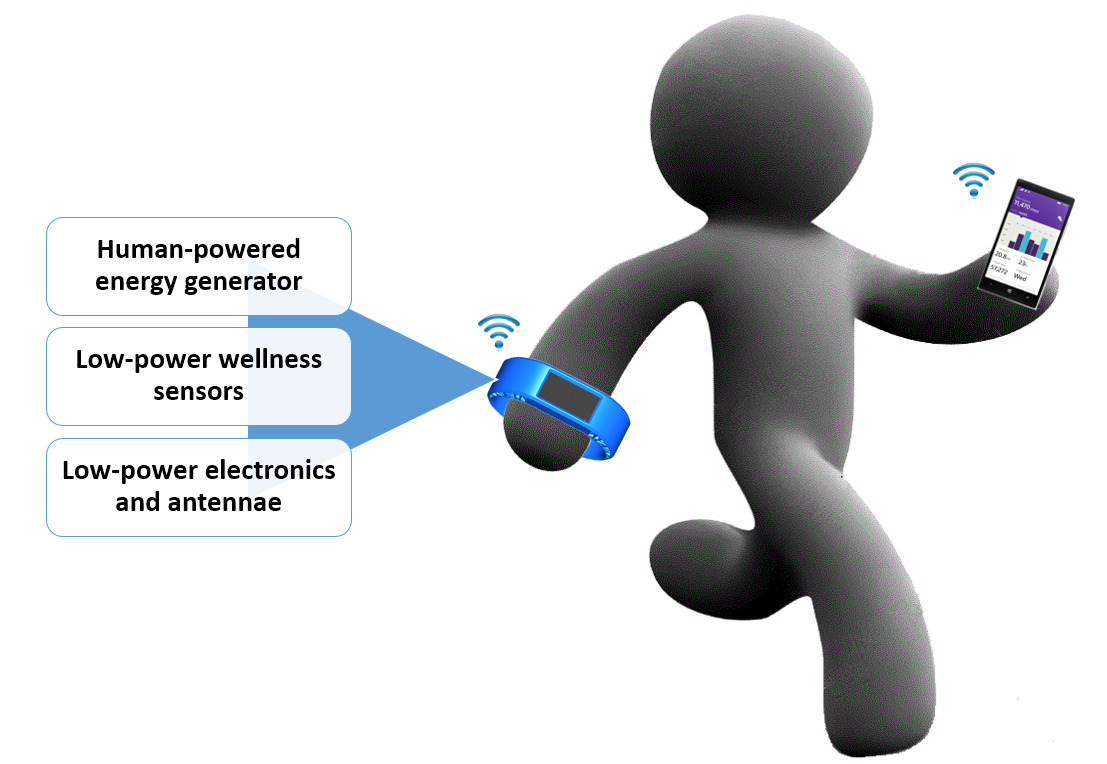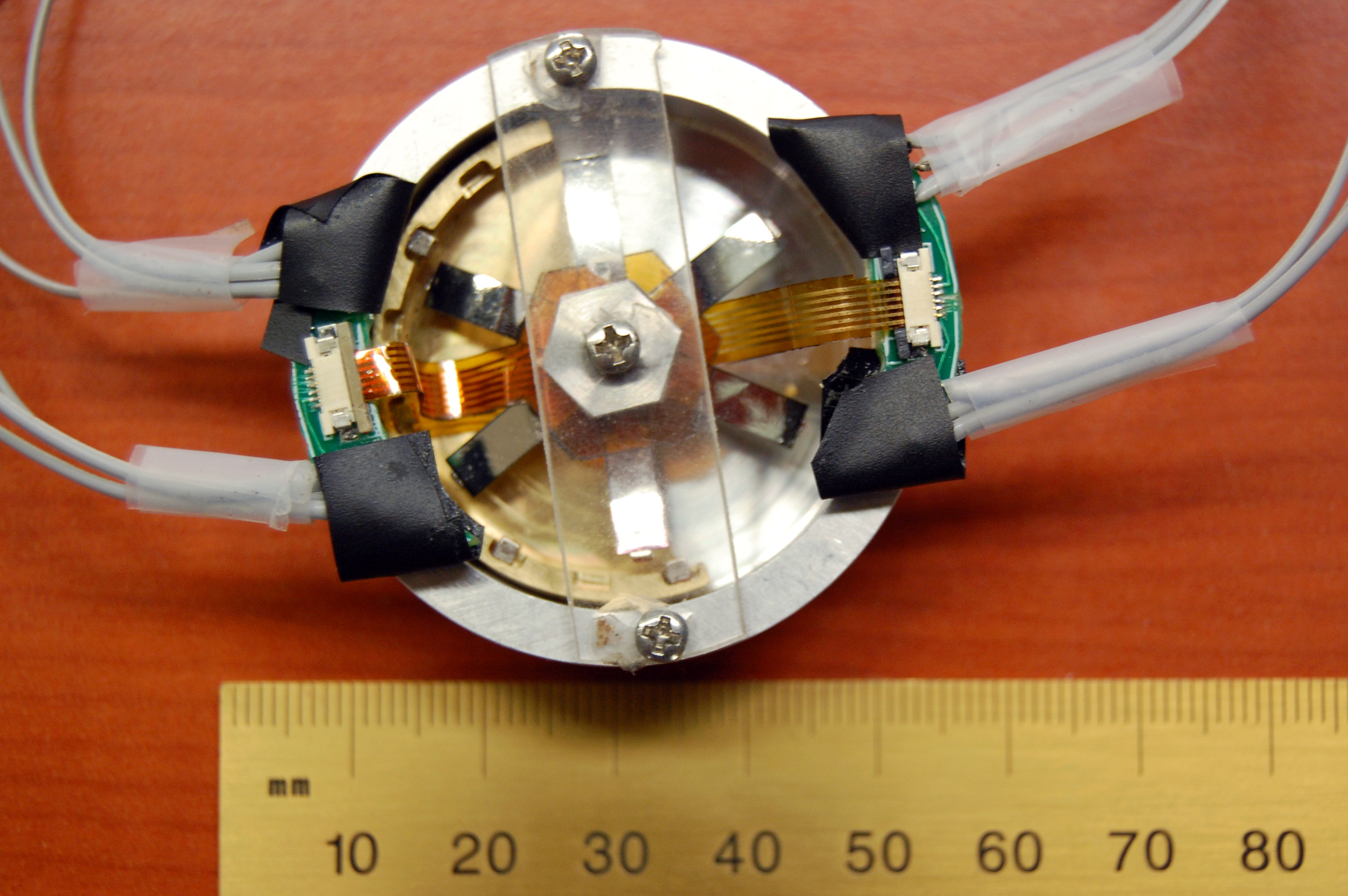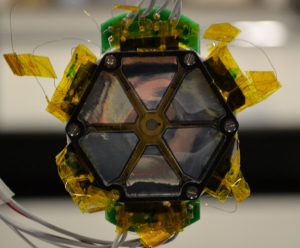
Wearable energy harvesting extracts energy from the human body itself. Potential sources include body heat, motion, exhalation and even blood pressure. We primarily investigate energy generation from human motion. Low and random frequencies of human motion make conventional resonant linear energy harvesters inadequate for such applications as they cannot benefit from the peak dynamic magnification. Thus we are applying rotational configuration in our non-resonant harvester prototype. In order to optimize the design, we are studying relationships of fundamental parameters between different components of the harvester system and its limit on power generation.
This project is part of the
ASSIST (The NSF Nanosystems Engineering Research Center for Advanced Self-Powered Systems of Integrated Sensors and Technologies) program. ASSIST aims at developing innovative battery-free, body-powered, and wearable health monitoring systems which integrate human-powered energy harvester, low-power wellness sensors and other essential electronics. Both sides of the power problem need to be addressed in order to enable a self-powered system: increasing the power harvested and decreasing the power consumed. On one hand, advances in nanotechnogies allow nanodevices to operate at minimal power. On the other hand, our goal is to optimize the power generation from human motion and narrow the gap between two sides to maximize the functionality of the self-powered health monitoring system.
Prototype of wrist-worn harvesting system with star-shape piezoelectric element  Prototype of wrist-worn harvesting system with petal-shape piezoelectric beams
Prototype of wrist-worn harvesting system with petal-shape piezoelectric beams  Video of petal-shape piezoelectric energy harvester directly flashing an LED
Video of petal-shape piezoelectric energy harvester directly flashing an LED
Researchers
Tiancheng Xue,
Bihn Duc Truong,
Rob Rantz and
Halim Miah
Collaborators
STM group at Penn State University
Publications
- Xue, T., Yeo, H. G., Trolier-McKinstry, S., Roundy, S., 2018. “Wearable inertial energy harvester with sputtered bimorph lead zirconate titanate (PZT) thin-film beams”, Smart Materials and Structures, 27 085026. [link]
- Yeo, H.G., Xue, T., Roundy, S., Ma, X., Rahn, C., Trolier-McKinstry, S., 2018 “Strong (001) Oriented Bimorph PZT Film on Metal Foils Grown by rf-Sputtering for Wrist-Worn Piezoelectric Energy Harvesters”, Advanced Functional Materials, 1801327. [link]
- Xue, T., Yeo, H.G., Trolier-McKinstry, S., Roundy, S. “A wrist-worn rotational energy harvester utilizing magnetically plucked {001} oriented bimorph PZT thin-film beams,” 2017 19th Int. Conf. Solid-State Sensors, Actuators Microsystems, pp. 375–378, 2017. [link]
- Xue, T., Roundy, S. “On magnetic plucking configurations for frequency up-converting mechanical energy harvesters.” Sensors and Actuators A: Physical 253 (2017): 101-111. [link]
- Rantz, R., et al. “Comparative Analysis of Wrist-worn Energy Harvesting Architectures.” Journal of Physics: Conference Series. Vol. 773. No. 1. IOP Publishing, 2016. [link]
- Zhang, Q., Gu, L., Yang, K., Miah, A.H., Rantz, R., and Roundy, S. 2016. “Kinetic Energy Harvesting Using Improved Eccentric Rotor Architectue for Wearable Sensors”, IEEE Sensors, Oct. 30 – Nov. 2, 2016, Orlando, FL.
- Xue, T., Kakkar, S. Lin, Q., and Roundy, S. 2016. “Characterization of Micro-Generators Embedded in Commercial-Off-the-Shelf Watches for Wearable Energy Harvesting”, SPIE Smart Structures and Materials+ Nondestructive Evaluation and Health Monitoring, pp. 98010O-98010O. International Society for Optics and Photonics, 2016. [link]
- Xue, T., and Roundy, S. 2015. “Analysis of Magnetic Plucking Configurations for Frequency Up-Converting Harvesters”, Journal of Physics: Conference Series. Vol. 660. No. 1. IOP Publishing, 2015. [link]
- Xue, T., et al. “Analysis of Upper Bound Power Output for a Wrist-Worn Rotational Energy Harvester from Real-World Measured Inputs.” Journal of Physics: Conference Series. Vol. 557. No. 1. IOP Publishing, 2014. [link]
Sponsors


 Wearable energy harvesting extracts energy from the human body itself. Potential sources include body heat, motion, exhalation and even blood pressure. We primarily investigate energy generation from human motion. Low and random frequencies of human motion make conventional resonant linear energy harvesters inadequate for such applications as they cannot benefit from the peak dynamic magnification. Thus we are applying rotational configuration in our non-resonant harvester prototype. In order to optimize the design, we are studying relationships of fundamental parameters between different components of the harvester system and its limit on power generation.
This project is part of the ASSIST (The NSF Nanosystems Engineering Research Center for Advanced Self-Powered Systems of Integrated Sensors and Technologies) program. ASSIST aims at developing innovative battery-free, body-powered, and wearable health monitoring systems which integrate human-powered energy harvester, low-power wellness sensors and other essential electronics. Both sides of the power problem need to be addressed in order to enable a self-powered system: increasing the power harvested and decreasing the power consumed. On one hand, advances in nanotechnogies allow nanodevices to operate at minimal power. On the other hand, our goal is to optimize the power generation from human motion and narrow the gap between two sides to maximize the functionality of the self-powered health monitoring system.
Prototype of wrist-worn harvesting system with star-shape piezoelectric element
Wearable energy harvesting extracts energy from the human body itself. Potential sources include body heat, motion, exhalation and even blood pressure. We primarily investigate energy generation from human motion. Low and random frequencies of human motion make conventional resonant linear energy harvesters inadequate for such applications as they cannot benefit from the peak dynamic magnification. Thus we are applying rotational configuration in our non-resonant harvester prototype. In order to optimize the design, we are studying relationships of fundamental parameters between different components of the harvester system and its limit on power generation.
This project is part of the ASSIST (The NSF Nanosystems Engineering Research Center for Advanced Self-Powered Systems of Integrated Sensors and Technologies) program. ASSIST aims at developing innovative battery-free, body-powered, and wearable health monitoring systems which integrate human-powered energy harvester, low-power wellness sensors and other essential electronics. Both sides of the power problem need to be addressed in order to enable a self-powered system: increasing the power harvested and decreasing the power consumed. On one hand, advances in nanotechnogies allow nanodevices to operate at minimal power. On the other hand, our goal is to optimize the power generation from human motion and narrow the gap between two sides to maximize the functionality of the self-powered health monitoring system.
Prototype of wrist-worn harvesting system with star-shape piezoelectric element  Prototype of wrist-worn harvesting system with petal-shape piezoelectric beams
Prototype of wrist-worn harvesting system with petal-shape piezoelectric beams  Video of petal-shape piezoelectric energy harvester directly flashing an LED
Video of petal-shape piezoelectric energy harvester directly flashing an LED



